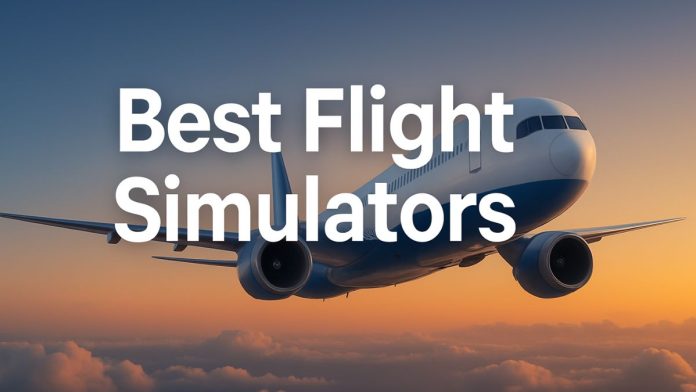Flight simulation has come a long way from pixelated cockpits and rudimentary scenery. In 2025, the world of virtual aviation is more immersive, realistic, and expansive than ever before. Whether you’re a budding pilot looking to hone your skills, a seasoned simmer chasing that perfect landing, or just a curious gamer fascinated by the sky, today’s flight simulators offer something for everyone. With cutting-edge graphics, real-world physics, and dynamic weather systems, the virtual skies are teeming with possibilities.
Thanks to advancements in AI, satellite imagery, and VR/AR technologies, developers have pushed the boundaries of what flight simulation can offer. From complex systems modeling to live multiplayer air traffic, the experiences are more authentic than ever. But with so many simulators on the market—some designed for hardcore aviation enthusiasts and others tailored to casual flyers—choosing the right one can be overwhelming. In this blog post, we’ll dive deep into the best flight simulators available in 2025.
Let’s Check Out the Best Flight Simulators in 2025
Here is our list of best flight simulators in 2025:
| Simulator | Price (Base) | Best For | VR Support | Platforms |
|---|---|---|---|---|
| MS Flight Simulator | $59.99+ | Realistic global flying | Yes | PC, Xbox Series X |
| X-Plane 12 | $59.99 | Serious aviation training | Yes | Windows/macOS/Linux |
| Aerofly FS 4 | $59.99 | Casual simmers/VR users | Yes | Windows, macOS |
| DCS World | Free (base) | Combat flight sim fans | Yes | Windows PC |
| FlightGear | Free | Education/experimenters | No | Windows/macOS/Linux |
| GeoFS | Free/$9.99 | Lightweight browser sim | No | Browser-based |
| Infinite Flight | Free/$9.99 | Mobile simming | No | iOS/Android |
| FlyInside | $34.99 | VR-focused flying | Yes (full) | Windows (VR) |

1. Microsoft Flight Simulator
Microsoft Flight Simulator continues to redefine virtual aviation in 2025. Originally released as MSFS 2024, this edition builds on its groundbreaking 2020 predecessor with even more realism, richer content, and a deeper connection to the real world. Using satellite data from Bing Maps and AI from Microsoft Azure, the sim renders a near-perfect digital twin of Earth—including live weather, terrain, and global air traffic. From flying over your hometown to navigating complex instrument procedures, every detail feels alive.
With over 40 handcrafted airports and an expanded fleet of highly detailed aircraft—from gliders and helicopters to airliners—the simulator caters to both casual pilots and serious simmers. New features in 2025 include enhanced air traffic control systems, dynamic seasons, mission-based gameplay, and better VR integration. Its massive modding community and third-party support allow users to tailor the experience to their preferences.
However, its realism comes at a cost: it requires a high-end PC or Xbox Series X|S to run smoothly and takes up significant storage space. Despite that, Microsoft Flight Simulator remains the gold standard in civil aviation simulation.
Price: Base version at $59.99, with Deluxe and Premium versions at $89.99 and $119.99 respectively.
2. X-Plane 12
X-Plane 12 continues to be a favorite among professional pilots, flight schools, and serious enthusiasts in 2025. Built on the foundation of Laminar Research’s highly accurate flight dynamics, this simulator uses real-world physics modeling through blade element theory—making aircraft behave as they would in real air. Whether you’re performing a short VFR hop or executing complex IFR procedures, the fidelity of the flight experience is unmatched.
The simulator features an improved weather engine with volumetric clouds, realistic precipitation, and dynamic lighting effects that rival real-life conditions. In 2025, recent updates have added better ATC logic, enhanced airport environments, and more detailed aircraft systems, all while maintaining excellent performance on modern systems.
One of its biggest strengths is its openness. Users can design their own aircraft, airports, or plugins, thanks to its mod-friendly architecture. The simulator also supports a wide range of hardware from yokes to multi-monitor setups and VR headsets.
On the downside, while visuals have improved, they still lag slightly behind Microsoft Flight Simulator. Some newcomers may find the interface and systems complex without guidance.
Price: $59.99 for the full version with lifetime updates.
Platform: Available for Windows, macOS, and Linux.
3. Aerofly FS 4
Aerofly FS 4 continues to be a standout choice for flight simulation enthusiasts in 2025, offering a blend of high-fidelity visuals and user-friendly design. Developed by IPACS, this simulator caters to both newcomers and seasoned pilots, providing a diverse fleet of aircraft—including airliners, helicopters, fighter jets, and gliders—with fully interactive 3D cockpits and custom-coded systems.
The simulator boasts a robust physics engine, delivering realistic flight and ground dynamics. Features like real-time multibody simulation and complex aerodynamics enhance the authenticity of the flying experience. Users can dynamically adjust flight conditions, including time of day, visibility, and cloud density, adding to the immersive environment.
In 2025, Aerofly FS 4 has expanded its offerings with new aircraft additions, such as the Airbus A350, and improvements in terrain detail and airport accuracy. The simulator supports VR, providing an even more engaging experience for users with compatible hardware.
Price: $59.99 on Steam; $34.99 on the Mac App Store, with additional in-app purchases available.
Platforms: Windows, macOS, Linux, iOS, Android, and Nintendo Switch.
4. DCS World
DCS World remains the gold standard for military flight simulation in 2025. Developed by Eagle Dynamics, it delivers an uncompromisingly realistic experience tailored to aviation enthusiasts, combat veterans, and real-world pilots alike. Featuring a modular platform, DCS World allows users to fly meticulously modeled military aircraft—from the F/A-18C Hornet and A-10C Warthog to the F-16C Viper and even helicopters like the AH-64D Apache.
Each aircraft features clickable cockpits, authentic avionics, and realistic weapon systems, all simulated to military-grade detail. DCS World also includes dynamic combat environments, detailed maps (such as Syria, South Atlantic, and Persian Gulf), and multiplayer support for cooperative and PvP missions.
In 2025, recent updates introduced new terrain, improved AI behaviors, and enhanced weather dynamics. The mission editor has become even more powerful, enabling the creation of detailed training or combat scenarios. VR support is also excellent, providing full immersion for those with headsets.
However, DCS World comes with a steep learning curve and high system requirements. Modules are sold individually and can be expensive, but the base game is free with two starter aircraft.
Price: Free to start; modules range from $14.99 to $79.99.
Platform: Windows PC only.
5. FlightGear
FlightGear is a powerful, fully open-source flight simulator that continues to thrive in 2025 thanks to its passionate community of developers and users. Designed with flexibility and realism in mind, FlightGear is ideal for students, hobbyists, and even academic institutions looking to explore aviation without commercial licensing restrictions. It includes a large library of user-contributed aircraft, from simple gliders to complex airliners, all featuring realistic physics and systems modeling.
What sets FlightGear apart is its open architecture. Users can modify nearly every aspect of the simulator, from weather and scenery to flight models and avionics. It uses real-world data for terrain, navigation aids, and airports, covering most of the globe. The visuals have improved over time, although they’re still not as polished as commercial competitors like MSFS or X-Plane.
In 2025, FlightGear has integrated better environmental effects, support for modern hardware (including multi-monitor and VR setups), and expanded multiplayer functionality. However, the learning curve for setup and customization remains steep, and the user interface can feel outdated.
Price: Completely free under the GNU General Public License.
Platforms: Windows, macOS, and Linux.
6. GeoFS
GeoFS is a lightweight, browser-based flight simulator that offers impressive accessibility and global coverage using real satellite imagery. As of 2025, it remains one of the most convenient and educational flight simulation platforms, perfect for casual users, students, and those without powerful gaming rigs. You can run GeoFS on virtually any device—PC, tablet, or Chromebook—making it one of the most inclusive simulators available.
The platform uses CesiumJS and satellite imagery to render a surprisingly detailed world. Users can fly a wide range of aircraft, from light planes and jets to balloons and military aircraft. It supports multiplayer flying, letting users interact with others in real time, and has a replay function and real-world weather data.
While GeoFS isn’t built for hardcore realism, it strikes a balance between simplicity and immersion. It lacks advanced aircraft systems modeling and complex physics, but for casual simming and educational use, it excels. It’s also an excellent introduction to aviation principles for students.
Price:
- Free version: Standard resolution and limited aircraft.
- HD version: $9.99/month for higher resolution, more aircraft, and additional features.
Platforms: Browser-based (any OS with a modern browser), and also available on mobile via Android and iOS apps.
7. Infinite Flight
Infinite Flight stands as one of the most advanced mobile flight simulators available in 2025. Designed specifically for smartphones and tablets, it offers an impressive balance of accessibility, realism, and visual quality. Available on iOS and Android, Infinite Flight allows users to enjoy a full-featured simulator experience on the go—ideal for casual simmers, students, and aviation fans who don’t have access to a gaming PC.
The simulator features a wide selection of aircraft, including airliners, general aviation planes, and military jets, all with realistic flight models and interactive cockpits. Infinite Flight’s global scenery—based on satellite imagery—and real-time weather contribute to a surprisingly immersive experience on mobile devices.
The standout feature is its multiplayer network, Infinite Flight Live, which supports real-time global air traffic, realistic ATC communications, and community events. The development team continues to add aircraft, rework models, and improve realism year after year.
While it doesn’t match the system depth of desktop simulators like DCS or MSFS, Infinite Flight offers an unmatched mobile experience. It requires a subscription for full features and multiplayer access.
Price: Free to download; Pro Subscription is $9.99/month or $79.99/year.
Platform: iOS and Android only.
8. FlyInside
FlyInside Flight Simulator stands out in 2025 as a VR-centric flight simulator, offering an immersive experience tailored for virtual reality enthusiasts. Developed by FlyInside Inc., this simulator was built from the ground up with VR in mind, ensuring seamless integration and performance optimization for VR headsets .
The simulator features a custom 64-bit engine designed to leverage modern GPUs and multi-core processors, delivering smooth performance even with dense scenery and realistic weather conditions . Users can pilot a variety of aircraft, including high-speed jets, helicopters, and general aviation planes, across the entire continental United States .
FlyInside supports various input methods, such as joysticks, gamepads, VR motion controllers, Leap Motion, and traditional keyboard/mouse setups . While optimized for VR, it also offers a desktop mode for those without VR equipment.
However, being in Early Access, FlyInside may lack some features found in more mature simulators, such as global scenery coverage and advanced ATC systems. Additionally, users have noted that while performance has improved since launch, it may still be demanding on certain systems .
Price: $34.99 on Steam.
Platform: Windows PC.
Conclusion
Choosing the best flight simulator in 2025 really depends on what kind of flying experience you’re looking for. Microsoft Flight Simulator continues to lead the pack with its breathtaking realism and global coverage, while X-Plane 12 remains a staple for those who crave physics-based accuracy and professional-grade features. For combat enthusiasts, DCS World is unmatched in military aviation realism. Mobile and casual users have strong options too, with Infinite Flight and GeoFS offering accessibility without sacrificing too much quality.
Whether you’re flying for fun, training for real-world aviation, or just looking to explore the Earth from the skies, there’s a simulator that fits your needs and budget. From free, open-source platforms to premium, feature-rich simulators, the sky is no longer the limit—it’s just the beginning. Try a few, find your favorite cockpit, and take off into the virtual skies.


![How to Use WhatsApp Web? [Beginners Friendly] how-to-use-whatsapp-web-thumb](https://www.internetoutsider.com/wp-content/uploads/2025/05/how-to-use-whatsapp-web-thumb-218x150.jpg)




